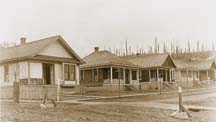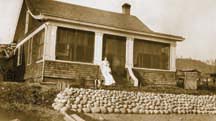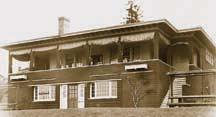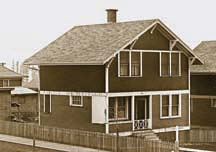The Powell River Townsite
In the beginning
By Gerry Gray
"What a dismal aspect" Captain George Vancouver wrote in his diary as he looked toward the shoreline from his ship, HMS Discovery, anchored west of Harwood Island. His commission was to chart the west coast of Canada for the British Government and he wrote in his diary, in 1791 that the coast was "chiefly composed of rugged rocks and thinly wooded with dwarf pine trees. He also noted "a small creek at the north end of the bay but never mentioned the huge lake a short mile up "the creek."
 Nearly a century later Dr. Israel Powell, surveying the coast as a surgeon aboard HMS Rocket, was more circumspect in his observations about our coast. He saw a sheltered port, a huge water supply and a tremendous forest of quality trees. In his report to the government he envisioned the area becoming a natural industrial site, and he was right. The lake and river were named after him by the Rocket Captain, Lt. Commander Vere Orlebar, R.N.
Nearly a century later Dr. Israel Powell, surveying the coast as a surgeon aboard HMS Rocket, was more circumspect in his observations about our coast. He saw a sheltered port, a huge water supply and a tremendous forest of quality trees. In his report to the government he envisioned the area becoming a natural industrial site, and he was right. The lake and river were named after him by the Rocket Captain, Lt. Commander Vere Orlebar, R.N.
By this time logging had already opened the doors to industry in the Stillwater/Lang Bay area. In 1908-1909 Brooks Scanlon logging operations in the Stillwater area, became interested in utilizing Powell Lake for power. The decision was made and finances put in place and in 1910 the company announced a two-machine newsprint plant was to be built in Powell River.
This announcement signalled the start of the Townsite.
The winter of 1910 saw hundreds of construction men on the site, building a dam so electricity could be ready for the construction of a newsprint mill to go on stream within two years. By the fall of that year machinery had been brought up from Vancouver to install two paper machines. By 1912 newsprint was rolling onto the dock and Powell River was on its way to becoming the largest newsprint mill in the world.
 Along with industrial progress there was the need to provide suitable housing for the hundreds of construction men employed by the Company. Directors realized that a Townsite would have to be carefully planned to last for decades. The area was therefore laid out with mathematical precision. Starting a new Townsite, remote from civic or municipal centers, was a lot different than establishing a campsite. The planners were dedicated to putting in place a modern industrial site with comfortable homes for its ever increasing employees needed to keep up with the expanding mill.
Along with industrial progress there was the need to provide suitable housing for the hundreds of construction men employed by the Company. Directors realized that a Townsite would have to be carefully planned to last for decades. The area was therefore laid out with mathematical precision. Starting a new Townsite, remote from civic or municipal centers, was a lot different than establishing a campsite. The planners were dedicated to putting in place a modern industrial site with comfortable homes for its ever increasing employees needed to keep up with the expanding mill.
Early in 1911 the first two houses were built, one for Dr. Andrew Henderson and a second home for Ernest Rowledge. A total of 21 homes were built that year. Soon houses lined Aspen Avenue and early in 1912 the resident managers' house was constructed. Today, if one looks down Marine Avenue from the corner of Ash they will see the nucleus of the present Townsite.
Even with houses going up like mushrooms still more effort was called for when the mill went on stream with two paper machines in 1912. Demand for newsprint was so high a four machine plant was brought forward. At the end of this year 53 new houses filled up Cedar, Poplar and Laburnum streets. Maple and Sycamore came next. In 1923 five and six machines were on stream. Number 7 went on stream in 1930--two years after Black Friday, the day the Stock Market collapsed creating world-wide depression. During the Depression, the Company ran a four-day schedule ensuring that its workers would stay in town and get enough work to live on.
 Most of the mill workers preferred to live in the Townsite because of its' proximity to their job, the spectacular view of Malaspina Strait and reasonable rent. The largest house was the residence of the mill manager, John Keayes. Then the Guest House was built. The block system laid out by the Company planners ensured the Townsite was proceeding in an orderly manner, the results of which can be seen to this day.
Most of the mill workers preferred to live in the Townsite because of its' proximity to their job, the spectacular view of Malaspina Strait and reasonable rent. The largest house was the residence of the mill manager, John Keayes. Then the Guest House was built. The block system laid out by the Company planners ensured the Townsite was proceeding in an orderly manner, the results of which can be seen to this day.
The Company, not really in the Townsite Business, made occupancy of the houses as accommodating as possible. Rentals for the first houses went for $8.75 a month for a four-room and $9.50 for a five-room. In 1915 rentals were based on $4 per room plus extras, which brought the lowest rentals to $19.25. The "extras" included steam heat, electricity supplied by the mill, maintenance, yard work, and even light bulb replacement. Not a bad deal for less than 20 bucks a month! In the winter some tenants would heat their homes by turning the electric stove on high and leave the oven door open. Ingenious when someone else was picking up the tab.
Soon a theatre (The Patricia), a company store, a church and all the other accoutrements of a well-populated village appeared.
 Today one can stand on the roof of the old steam plant and see how the town was laid out with every need within walking distance. When the Townsite was planned cars were still a novelty enjoyed by city folk. Most of the houses built during the early 1900s are still occupied as is most of the business section, a credit to the local lumber and the builders who constructed them. Lumber was produced by a sawmill built on the site where the old Townsite firehall stood.
Today one can stand on the roof of the old steam plant and see how the town was laid out with every need within walking distance. When the Townsite was planned cars were still a novelty enjoyed by city folk. Most of the houses built during the early 1900s are still occupied as is most of the business section, a credit to the local lumber and the builders who constructed them. Lumber was produced by a sawmill built on the site where the old Townsite firehall stood.
 Following the large plant expansion in 1925, house construction increased and within two years 114 buildings were erected to bring the total to 500. The Company maintained building for the next 10 years and when the Municipality was formed in 1955 the rent roll for the Townsite was 500 and the population of Powell River was over 10,000.
Following the large plant expansion in 1925, house construction increased and within two years 114 buildings were erected to bring the total to 500. The Company maintained building for the next 10 years and when the Municipality was formed in 1955 the rent roll for the Townsite was 500 and the population of Powell River was over 10,000.
But the Townsite business was getting expensive for the Company. The cost of taxes, labour, maintenance and the increasing in the population was skyrocketing. Following the installation of Number 7 machine in 1930, the Company gradually sold the Townsite to tenants who wanted to buy and after 10 years the few houses unsold were held for workers constructing Number 8 Paper Machine. Building was continued for the next 10 years and when the Municipality was formed in 1955 the Company leased Dwight Hall, the lawn bowling green, Timberlane Park and other sundry lands within the Townsite.
It's hard to believe, today, when this coast was first charted by Captain George Vancouver in 1791 he described it so poorly in his diary. It was lucky Dr. Powell had a more discerning eye for industry than the good Captain.
Information for this history was derived from Harry Taylor's Powell River's First 50 Years published by the Powell River News and Al Alsgard. Thank you to Peter Sansburn, Coordinator of the Townsite Heritage Society for his assistance.